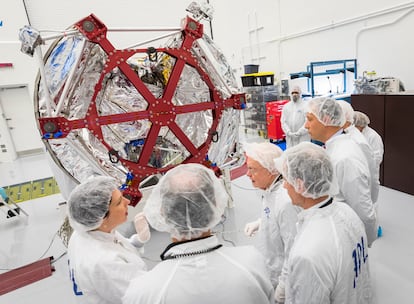"¡Rumbo al Sol! 'Parker Solar', la nave espacial más rápida de la historia, se acercará a solo 3.8 millones de millas de nuestra estrella"

Desde que la Parker Solar Probe (PSP) fue lanzada al espacio en 2018, ha logrado una serie de hazañas impresionantes. En 2021, se convirtió en la primera nave espacial en "tocar el Sol", al atravesar su corona sin derretirse a causa de las temperaturas devastadoras, pasando varias horas en su atmósfera. Un año después, resistió una colosal erupción solar y, el pasado noviembre, sobrevoló Venus sin desintegrarse, ajustando su trayectoria orbital final. Este evento permitirá que la Parker se acerque a tan solo 3.8 millones de millas (6.1 millones de kilómetros) de la superficie de nuestra estrella el martes, lo que representa casi el doble de la proximidad que alcanzó hace tres años.
On Christmas Eve, at 12:48 p.m. GMT, the probe will reach a speed of 429,989 mph (692,000 km/h) as it approaches solar maximum, the phase of greatest activity of the Sun, which occurs every 11 years. This encounter is consecrated as one of the greatest milestones of the space race, says Teresa Nieves Chinchilla, a Spanish heliophysicist and scientific director at NASA of another mission, the Solar Orbiter, which investigates the star’s electromagnetic field. “The Parker Solar is the fastest object that humans have ever built. There isn’t enough fuel to take the ships to great distances, so what we did was use the gravitational assist of Venus to modify the trajectory,” this expert from NASA’s Goddard Space Flight Center, who has been studying the Solar System’s primary star for two decades, tells EL PAÍS from Washington, D.C.
The spacecraft was launched on August 12, 2018. From Earth, which is located at an average distance of 150 million kilometers from the Sun, it has been traveling around our cosmic neighborhood, gradually approaching the star and collecting measurements and images of its behavior, using instruments such as an antenna and several magnetometers. The purpose of the mission is to decipher why some layers of the solar atmosphere can reach temperatures of millions of degrees, while the visible surface — the photosphere — is estimated to be about 5,000ºC. On this occasion, Parker Solar will once again fly over the corona, the outermost layer of the solar atmosphere composed of plasma. Although this is the closest distance to the Sun that an object launched into space by humans has ever reached, six million kilometers is — on the scale of our planet — a huge distance: 15 times greater than the distance that separates the Moon from the Earth.


¡Navidad temblorosa! Sismos y erupciones volcánicas sorprenden al país durante las festividades.

Medellín: cinco sucesos trágicos que han marcado la Navidad en Antioquia.

Manuel Valls: el político que resurge una y otra vez | Internacional | EL PAÍS

¡Bolsa española, reina de los dividendos! Descubre por qué es el mercado líder en retribución al accionista | Negocios | EL PAÍS

"Caída repentina de Ozempic en el mercado: ¿Qué significa para los inversores?" | Fondos y Planes | Cinco Días

"En el actual panorama geopolítico, es poco probable que la UE diga 'no' al acuerdo con Mercosur" | Economía | EL PAÍS

